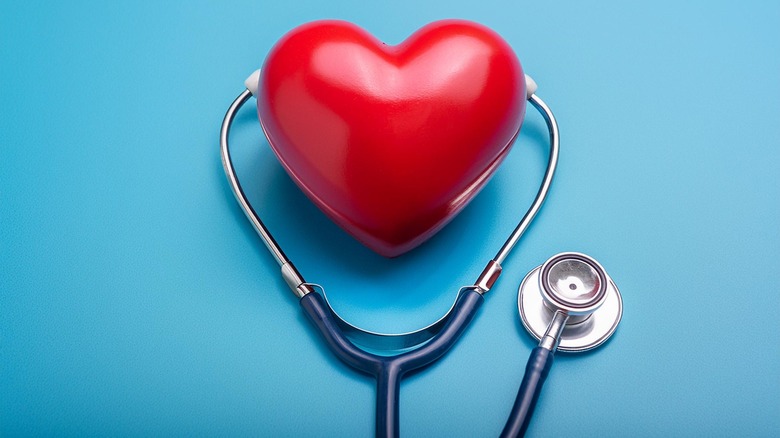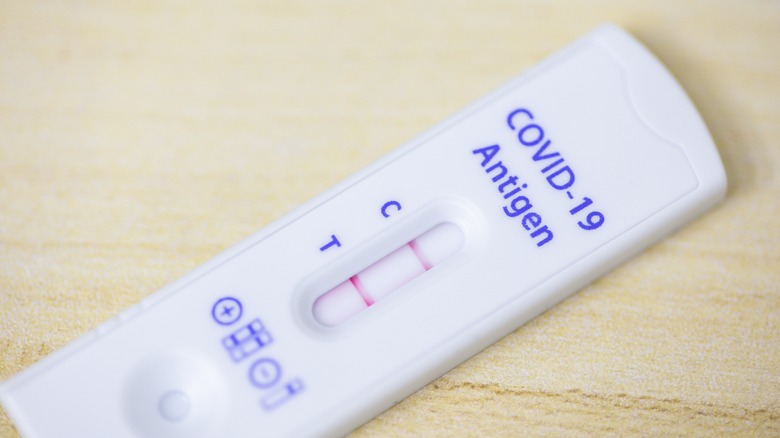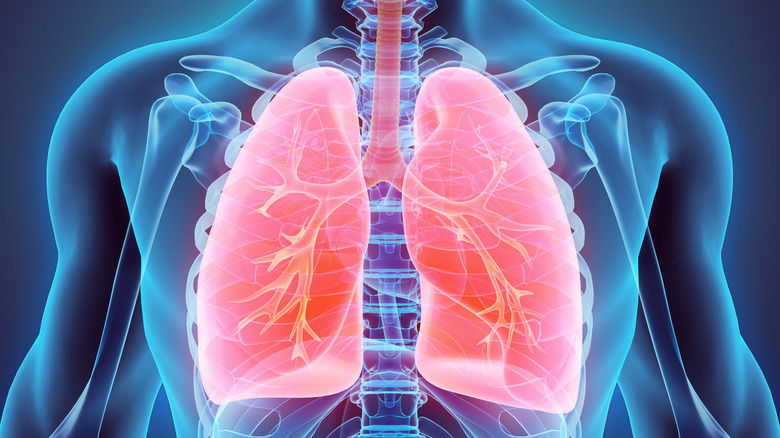The Top 10 Causes Of Death In The World
It's never easy to talk about death. It's a topic that many of us instinctively avoid, perhaps because it forces us to confront the fragility of life and the inevitability of our own mortality. Yet, no matter our age, health, or wealth, death is something we will all face — one day, one way or another. Exploring the leading causes of death worldwide might feel uncomfortable, even somber, but it holds invaluable insights into how we live, the quality of our health, and the challenges that we, as a global community, face. The top causes of death reveal more than just medical facts; they tell stories of global inequalities, cultural struggles, and shifting public health landscapes. Behind the data are the complexities of modern life, where preventable diseases, lifestyle factors, and socio-economic influences intersect to shape mortality on a massive scale.
In 2021, the World Health Organization (WHO) reported that the top 10 causes of death were responsible for 39 million (more than half) of the 68 million deaths worldwide. Most of the leading causes of death globally are from chronic, non-communicable diseases — health conditions that develop slowly over time and cannot be spread from person to person. These chronic conditions are often linked to lifestyle factors, such as diet, exercise, smoking, and genetic predispositions. Learning about the risks of these long-term diseases and how to prevent them is an important step in living a long, healthy life.
Coronary heart disease
Our heart is crucial because, without it, the cells in our body would cease to exist. Coronary heart disease, also called coronary artery disease or ischemic heart disease, is the number one cause of death not only in the United States but also worldwide. It's often referred to as the "silent killer" because many individuals are unaware they have it. People often experience no noticeable symptoms until it's too late, leading to a heart attack, which can be life-threatening. For this reason, it's important to visit your doctor for regular check-ups for heart disease.
Coronary heart disease has several causes, including plaque buildup and issues affecting the heart's blood vessel function, according to the National Heart, Lung, and Blood Institute. The risk of developing heart disease is influenced by various factors, some of which are beyond our control, such as age, genetics, and environmental conditions. However, numerous lifestyle choices can increase your risk, including lack of exercise, smoking, poor sleep, and an unhealthy diet. Additionally, several health conditions, like high blood pressure, high cholesterol, obesity, and diabetes, also elevate the likelihood of heart disease.
The good news is that many of these medical conditions — particularly high blood pressure and high cholesterol — can be managed through dietary and lifestyle changes. If you're concerned about your risk for heart disease, it's a good idea to consult your doctor for a health screening and to explore practical steps to lower your risk.
COVID-19
In 2021, COVID-19 was the second leading cause of death globally. Since then, reported deaths from COVID-19 have fluctuated, with a slow but steady decline from 2021 to 2024. In a single week during January 2021, COVID-19 contributed to 104,000 global deaths. In 2022, the highest weekly death toll reached 76,500, and in 2023, it peaked at 69,700. So far in 2024, the highest recorded weekly deaths have been 4,300 — a dramatic drop from 2021.
Overall, COVID-19 has claimed over 7.1 million lives globally, according to WHO. However, it's important to note that the WHO believes the reported numbers of cases and deaths are likely inaccurate and may underrepresent the true figures. Currently, the data shows that COVID-19 is still in the top 10 causes of death worldwide, but it has likely dropped from its previous position as the second leading cause. In 2023, COVID-19 oscillated between the third and fifth leading cause of death worldwide, depending on the data source (via Think Global Health).
COVID-19 is one of the few contagious diseases in the top 10 list. By now, most of us have heard time and time again the most effective ways to reduce your risk of getting COVID-19: wearing masks, hand hygiene, vaccinations, social distancing, and avoiding contact with those who are sick.
Strokes
A stroke is a medical emergency that occurs when the blood flow to the brain is interrupted, depriving brain cells of oxygen and nutrients. Without this supply, brain cells begin to die, which can lead to brain damage, loss of function, and even death if not treated promptly. Strokes are one of the most deadly medical conditions worldwide, killing 5 million people across the globe every year, according to Medical News Today. Another scary statistic: that number is projected to double to 10 million people each year by 2050.
Sadly, those lucky enough to survive a stroke often have complicated lingering disabilities, like struggling to relearn how to walk and speak and even life-altering emotional and behavioral changes. Noticing the symptoms of a stroke and seeking fast medical attention can help decrease the chances of long-term aftereffects. Some of the first signs of a stroke include trouble speaking, walking, or thinking; vision problems; numbness, weakness, or paralysis on one side of the body; and a headache.
Fortunately, there are steps you can take to lower your risk of stroke, such as adopting healthier lifestyle habits and effectively managing or preventing medical conditions like high blood pressure, high cholesterol, diabetes, and obesity. The Mayo Clinic also recommends embracing a healthy diet and adequate exercise, in addition to limiting your consumption of alcohol, drugs, and tobacco. While it's tempting to brush off these suggestions, these actions can really have a powerful impact on your health and overall quality of life.
Chronic obstructive pulmonary disease
Chronic obstructive pulmonary disease (COPD) causes damage and inflammation in the lungs, leading to other health conditions like emphysema and chronic bronchitis (per the Mayo Clinic). Common causes of COPD include smoking tobacco and long-term exposure to air pollution such as fumes, dust, or chemicals. COPD can leave you susceptible to other complicated health issues that can be life-threatening, like severe cases of the flu and pneumonia, lung cancer, heart problems, and pulmonary hypertension. Common symptoms of COPD include getting winding easily, wheezing, chronic cough, chest tightness, fatigue, unexpected weight loss, and frequent lung infections.
The bad news is that COPD is not curable. It is a progressive lung disease that tends to worsen over time. However, on the positive side, COPD is manageable, with various treatment options available that can enhance quality of life and lower the risk of other associated medical conditions, such as heart disease and cancer. If you're experiencing any signs of COPD, it's important to make a doctor's appointment now to schedule a health check.
Lower respiratory infections
Lower respiratory infections are one of the few medical conditions on the list of top 10 causes of death globally that are communicable, meaning they spread easily from one person to another. Sometimes it can be hard to tell the difference between an upper respiratory infection (like the common cold or a sinus infection) and a lower respiratory infection because the two have very similar symptoms. Lower respiratory tract infections include bronchitis, pneumonia, bronchiolitis, and tuberculosis and can be caused by viruses, like the flu or respiratory syncytial virus (RSV), bacteria like Strep, fungal infections, or mycoplasma (via Medical News Today). These conditions can be deadly, killing 2.5 million people globally in 2021, according to the WHO.
Many people who get lower respiratory infections find they resolve on their own or with the help of over-the-counter medications. Some patients need to take antibiotics or use an inhaler to recover from the illness. Unfortunately, for those with underlying health conditions or over the age of 65 or children under 5 years old, the risk of complications is higher, which can cause conditions like congestive heart failure, respiratory failure, respiratory arrest, sepsis, or lung abscesses — all of which can be fatal. This is why washing your hands often and staying home when you are sick are two very important actions, as they can help prevent yourself and others from getting and spreading lower respiratory infections.
Trachea, bronchus and lung cancers
The trachea, bronchus, and lungs are all part of the respiratory system — and trachea, bronchus, and lung cancers are a high cause for concern. A 2022 study published in eBioMedicine states: "Globally, tracheal, bronchus, and lung cancer (TBL) is the second most common cancer and has been ranked as the top cause of cancer-related mortality in 2020, accounting for approximately 2.2 million new cases and almost 1.8 million deaths. According to the Cancer Tomorrow online tool of the GLOBOCAN, the incident cases are estimated to increase by around 64% by 2040, whereas death cases are estimated to increase by about 67%."
So, why are these cancers so common, and the most deadly? The challenge with these types of cancers is that symptoms in the early stages are often subtle, such as a persistent cough, shortness of breath, wheezing, chest pain, loss of appetite, fatigue, or shoulder pain. Many people tend to dismiss these signs or attribute them to stress or anxiety — an understandable but dangerous mistake.
Approximately 80% of lung cancer deaths are linked to smoking, yet 20% of cases occur in non-smokers. If you experience any concerning symptoms or think you might be at risk, it's essential to consult your doctor sooner rather than later.
Alzheimer's disease and dementia
Responsible for 1.8 million deaths (based on 2021 data), the WHO ranked Alzheimer's disease and other forms of dementia seventh among the world's top causes of death. Alzheimer's disease is the most common type of dementia, a decline in cognitive function that affects a person's memory, thinking, behavior, and ability to perform everyday activities. It is caused by the death of nerve and brain cells and typically occurs in individuals over the age of 65. Per the Cleveland Clinic, one in every 10 people above 65 years of age and about 33% of people above 85 suffer from it.
Alzheimer's disease and dementia impact people in different ways. Some people experience mild symptoms, while others are more severe. Typically, people experience at least two or more of the following symptoms: memory loss, difficulty reasoning, challenges completing complex tasks, speech struggles, trouble understanding visual form and space relationships, and behavior and personality shifts. Unfortunately, there is no cure for Alzheimer's disease, and the condition gets worse over time. However, medications and therapy techniques can help manage the symptoms and improve the quality of life.
Alzheimer's disease and dementia affect patients not only physically but also mentally and emotionally, with these effects often extending to their loved ones. Navigating this journey can be challenging. The best way to prepare is by consulting healthcare providers and therapists who specialize in Alzheimer's disease and dementia. Don't hesitate to reach out for support.
Diabetes
Diabetes mellitus is a medical condition that affects your blood sugar levels. Approximately 2 million deaths in 2019 were attributed to diabetes and diabetes-related kidney disease, per WHO. Type 1 diabetes is linked to autoimmune disease and usually diagnosed in children and young adults; meanwhile, type 2 diabetes is typically a result of insulin resistance and is common in adults. According to the Cleveland Clinic, about 10% of diabetes cases are type 1, and almost 90% are type 2. Globally, approximately 537 million adults have diabetes, and this number is projected to increase to 643 million by 2030.
Diabetes is a chronic condition, meaning once you develop it, you will have it for life. Treatment options include monitoring blood sugar levels, insulin injections, oral medications, and diet changes. There are some life-threatening long-term diabetes complications, like heart disease, stroke, kidney failure, nerve damage, amputations, and more. While there is no way to prevent type 1 diabetes, you can lower your risk of type 2 diabetes by adopting a healthy diet, being physically active, getting enough sleep every night, and managing your weight and stress. Research indicates that some cases of type 2 diabetes may be reversible, causing patients to go into remission (via WebMD). Most remission cases are linked to successful shifts in diet and lifestyle changes resulting in weight loss.
Kidney disease
Chronic kidney disease, also known as chronic kidney failure, is characterized by the gradual decline of kidney function. Interestingly, the WHO writes that "kidney diseases have risen from the world's nineteenth leading cause of death to the ninth, with the number of deaths increasing by 95% between 2000 and 2021." A recent article in Nature deemed kidney disease the "third-fastest-growing cause of death globally." What's behind the sharp rise? Several factors come into play. To begin with, kidney disease is closely linked to diabetes and heart disease, both of which are also dramatically increasing worldwide. In addition, experts point to the impacts of global climate change, such as rising temperatures and decreased access to fresh drinking water.
Kidney disease is marked by nausea, vomiting, loss of appetite, fatigue, weakness, sleep issues, changes in urination, decreased mental clarity, feet or ankle swelling, and uncontrollable high blood pressure. Chronic kidney disease often occurs when a medical condition negatively impacts kidney function. To lower your risk of developing this disease, Mayo Clinic recommends adopting healthy lifestyle practices like managing your weight and avoiding smoking. They also advise using over-the-counter pain relievers carefully, as overuse can harm the kidneys.
Tuberculosis
Tuberculosis or TB is a bacterial infection that impacts the lungs and can be fatal if left untreated. In 2022, about 1.3 million people worldwide died from TB, making it the second leading infectious killer after COVID-19, surpassing HIV and AIDS (per WHO). TB is curable, but not everyone has access to treatment. According to the Cleveland Clinic, the disease was formerly a top cause of death in the U.S. in the 1900s, but experienced a sharp decline in recorded cases decades later after treatments were discovered. Nevertheless, TB remains a global problem, with most cases detected in low- and middle-income countries.
Symptoms of TB mimic those of COVID or the flu, including fever, chills, fatigue, night sweats, and chest pain. A telltale sign of TB is a persistent cough, often lasting two weeks or longer. If you suspect you have TB, it's important to visit your doctor for a screening. The common treatment for TB is antibiotics. However, some types of TB have become antibiotic-resistant, so it's important to monitor your symptoms and work closely with your healthcare provider for continued care.










